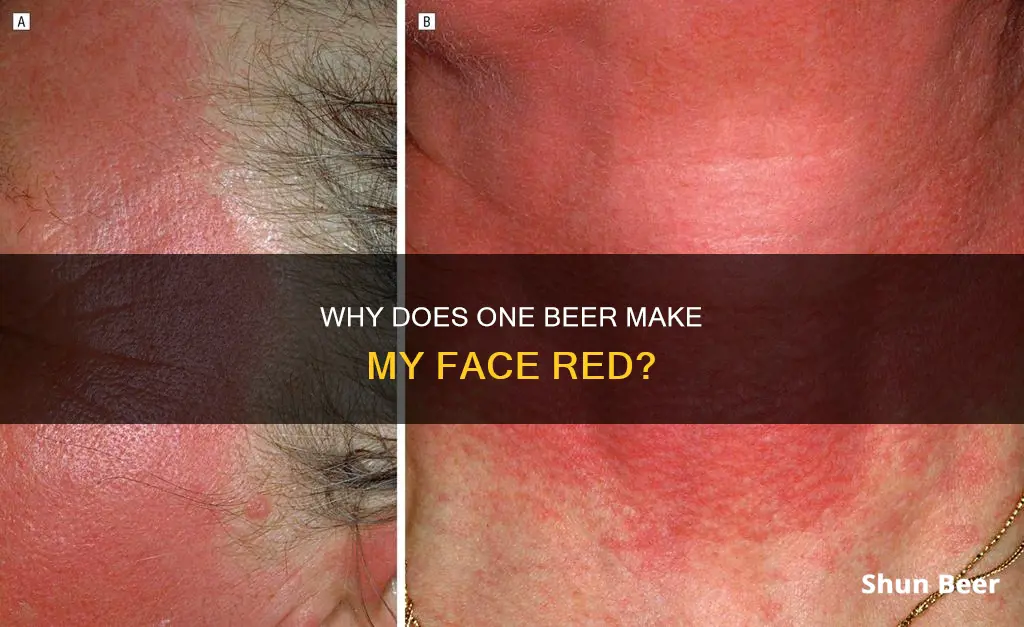
Drinking alcohol can cause a person's face to turn red due to a variety of factors, including ethnicity, genetic makeup, and the type of alcohol consumed. This phenomenon, known as alcohol flush reaction, occurs when the body cannot metabolize alcohol effectively, leading to a buildup of acetaldehyde, a toxic metabolite. While the red flush itself is not dangerous, it indicates high alcohol sensitivity and an increased risk of health issues such as high blood pressure and certain types of cancer. People of East Asian descent are more likely to experience this reaction due to a deficiency in the enzyme alcohol dehydrogenase, which breaks down acetaldehyde. Additionally, fair-skinned individuals of Northern European descent may have rosacea, a skin condition that can also cause facial flushing when drinking alcohol. Other factors that can contribute to flushing include dehydration, specific ingredients in certain types of alcohol, and underlying allergies or intolerances.
| Characteristics | Values |
|---|---|
| Cause | Intolerance or sensitivity to alcohol and its metabolite acetaldehyde |
| Occurrence | More common in people of East Asian descent |
| Symptoms | Reddening of the skin, rapid heartbeat, nausea, difficulty breathing |
| Risk Factors | High blood pressure, certain types of cancer, stomach problems, liver disease |
| Prevention | Limit alcohol consumption, choose lighter-coloured drinks, use supplements to aid acetaldehyde breakdown |
What You'll Learn

Alcohol flush reaction
The alcohol flush reaction is commonly observed in individuals of East Asian descent, with 30-50% of Chinese, Japanese, and Korean individuals experiencing this reaction. It is also prevalent in some Southeast Asian and Inuit populations. The condition is associated with lower-than-average rates of alcoholism due to the unpleasant side effects, which can include facial flushing, nausea, headaches, and a fast heart rate.
The accumulation of acetaldehyde can trigger a histamine release, resulting in dilation of the facial blood vessels and skin discoloration. This reaction can vary depending on skin tone, with visible reddening on lighter skin tones and discoloration or darkening on darker skin tones. While the flush itself is not dangerous, it indicates high alcohol sensitivity and an increased risk of high blood pressure and certain types of cancer, particularly esophageal cancer.
The only way to prevent the alcohol flush reaction is to avoid or limit alcohol intake. While over-the-counter antihistamines can reduce skin discolouration, they are not recommended by experts as they only mask the symptoms without addressing the underlying cause.
Beer and Cipro: Is It Safe to Drink?
You may want to see also

High alcohol sensitivity
The physical reaction of facial flushing is the body's way of signalling that it is not processing alcohol properly. This flush response, also known as Asian Flush or Asian Glow, is particularly common among individuals of East Asian descent, affecting more than 50% of this population. However, it can occur in people of various skin tones, nationalities, and ages.
The root cause of high alcohol sensitivity is typically an enzyme deficiency or rosacea. Many East Asian populations have a deficiency in alcohol dehydrogenase, the enzyme responsible for breaking down acetaldehyde. As a result, individuals with this deficiency can experience toxic levels of acetaldehyde in their bodies after consuming even small amounts of alcohol, leading to facial flushing.
Fair-skinned individuals of Northern European backgrounds who experience flushing may have some degree of rosacea. Rosacea is a chronic inflammatory skin disorder characterised by enlarged blood vessels on the face, particularly the cheeks. It can cause persistent redness, a tendency to blush or flush easily, a burning or itching sensation, dryness, swelling, and increased skin sensitivity.
While the facial flush itself is not dangerous, it indicates a higher risk of high blood pressure and other health issues. Studies have linked facial flushing with an increased risk of certain types of cancer, particularly esophageal cancer. Therefore, it is important for individuals who experience high alcohol sensitivity to limit their alcohol intake or abstain altogether.
Millenials' Beer Consumption: A Changing Taste Perspective
You may want to see also

Acetaldehyde toxicity
Acetaldehyde is a naturally occurring organic compound found in ripe fruit, coffee, and beer. It is produced by yeast during the conversion of glucose to ethanol and is present in all beers to some extent. While it is intended to add a fresh crispness to the beer, if present in high concentrations, it can be indicative of problems in the brewing process.
Acetaldehyde is toxic to the body and can cause a histamine release, resulting in flushing and other symptoms. This is known as the alcohol flush reaction and occurs when the body cannot metabolize alcohol effectively, leading to a buildup of acetaldehyde. This reaction is more common in people of East Asian descent, who often have a deficiency in alcohol dehydrogenase, the enzyme that breaks down acetaldehyde.
The symptoms of acetaldehyde toxicity include a red facial flush, rapid heartbeat, and nausea. The facial flush occurs due to the dilation of blood vessels in the face in response to the toxins. This reaction is not dangerous in itself, but it can indicate a higher risk of high blood pressure and other health issues, including certain types of cancer.
To prevent acetaldehyde toxicity, it is important to avoid or limit alcohol intake, especially if you have a known enzyme deficiency. Over-the-counter antihistamines can reduce the discoloration associated with the flush, but they do not address the underlying cause and are not recommended by experts.
Drinking Beer at Foroya Bjor: What's the Deal?
You may want to see also

Rosacea
Causes
While the exact cause of rosacea is unknown, research suggests that drinking alcohol may increase a person's risk of developing the condition. A study published in the Journal of the American Academy of Dermatology found that women who drank alcohol had a higher risk of developing rosacea than those who didn't, and this risk increased with the amount of alcohol consumed.
Alcohol and Rosacea
The link between alcohol and rosacea is due to the inflammatory effects of alcohol on the body. Alcohol causes blood vessels to dilate, which can exacerbate rosacea. Additionally, alcohol can increase the production of inflammatory cytokines, which also cause blood vessels to widen.
Managing Rosacea
If you have rosacea, there are several things you can do to lower your risk of a flare-up when drinking alcohol:
- Opt for chilled white wine over room-temperature red wine.
- Keep track of flares to determine which alcoholic drinks you can tolerate. Some people with rosacea have fewer problems with beer than with wine.
- Drink slowly and in moderation to lower your cumulative alcohol intake.
- Alternate alcoholic drinks with a glass of water to stay hydrated, as dehydration can lead to skin sensitivity.
- Avoid hot and spicy foods when drinking alcohol, as these can dilate blood vessels.
- Choose high-fat foods to slow the absorption of alcohol in the body.
- Opt for a mocktail or a non-alcoholic drink instead of alcohol.
Treatment
If you are experiencing rosacea, it is recommended to see a dermatologist for an accurate diagnosis and treatment plan. Treatments for rosacea include topical medications and laser treatments to shrink the superficial blood vessels in the skin. Antibiotics may also be prescribed to manage eye symptoms associated with rosacea.
While rosacea can cause cosmetic concerns, it is important to remember that it is not a precancerous disease. The biggest problems caused by rosacea are typically a bulbous nose and eye inflammation.
Beer's Impact on Blood Sugar: What You Need to Know
You may want to see also

Asian flush
The "Asian flush" is the informal term for the alcohol flush reaction that occurs in people of East Asian descent due to an enzyme deficiency. This reaction is the result of an accumulation of acetaldehyde, a toxic metabolic byproduct of alcohol. The condition may also be prevalent in some Southeast Asian and Inuit populations.
Around 30-50% of people of Chinese, Japanese, and Korean descent show characteristic physiological responses to drinking alcohol, including facial flushing, nausea, headaches, and a fast heart rate. This is because many East Asians have a variant in the ADH gene, which results in a less functional acetaldehyde dehydrogenase enzyme responsible for breaking down acetaldehyde. Additionally, in about 80% of East Asians, the rapid accumulation of acetaldehyde is worsened by another gene variant, the allele ADH1B*2, which converts alcohol to acetaldehyde more quickly.
The alcohol flush reaction is a type of alcohol intolerance caused by inherited variations in the genes of certain enzymes, leading to less efficient metabolization of alcohol. During alcohol metabolism, the enzyme alcohol dehydrogenase (ADH) converts alcohol to acetaldehyde, which is then metabolized into non-toxic molecules by another enzyme called aldehyde dehydrogenase (ALDH). If a person is deficient in ALDH, or if their ADH is less functional, acetaldehyde can build up in the body and cause a histamine release, resulting in flushing and other symptoms.
The red flush itself is not dangerous, but people who experience it are at a higher risk of high blood pressure and other health issues, including certain types of cancer. A 2013 study of Korean men found that those who flushed after drinking had a very high risk of high blood pressure when they drank four or more drinks per week, while those who did not flush did not see an increased risk until they drank eight or more drinks per week. A 2017 study also showed that men with facial flushing had a higher risk of cancer, particularly esophageal cancer, but this link was not found in women.
The only way to prevent this red flush and the associated health risks is to avoid alcohol or limit intake. While some people use over-the-counter antihistamines to reduce the skin discolouration, this is not recommended by experts.
Giving Up Beer: Strategies for a Healthier You
You may want to see also
Frequently asked questions
Your body may be unable to metabolise alcohol effectively, leading to a buildup of acetaldehyde, which is toxic and can cause a histamine release, resulting in flushing.
Facial flushing itself is not dangerous, but it may indicate a higher risk of serious health issues such as high blood pressure and certain types of cancer.
Facial flushing is caused by an intolerance or sensitivity to alcohol and its metabolite, acetaldehyde. This can be due to a defect in liver enzymes, preventing the body from properly metabolising alcohol.
While there is no cure for facial flushing, you can limit alcohol consumption, choose lighter-coloured drinks, and use supplements to aid acetaldehyde breakdown.







